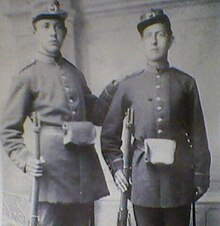| Serbian Model 1878/80 (Mauser-Koka) | |
|---|---|
 Serbian cadets with Mauser-Koka Serbian cadets with Mauser-Koka | |
| Type | Service rifle |
| Place of origin | Kingdom of Serbia |
| Service history | |
| In service | 1881–1918 |
| Used by | Kingdom of Serbia |
| Wars | Serbo-Bulgarian War Balkan Wars World War I (limited) World War II (limited) |
| Production history | |
| Designer | Mauser |
| Designed | 1871, 1880 |
| Manufacturer | Mauser, Zastava Arms |
| Variants | Mauser-Koka-Đurić |
| Specifications | |
| Mass | 4.5 kg (9.92 lbs) |
| Length | 1350 mm (53.15 in) |
| Barrel length | 855 mm (33.66 in) |
| Cartridge | 10.15×63 mm |
| Caliber | .43 |
| Action | Bolt action |
| Muzzle velocity | 1,680 feet per second (510 m/s) |
| Feed system | Single-shot |
| Sights | Iron sights |
In 1880, Serbian Major Kosta "Koka" Milovanović (Коста "Кока" Миловановић) developed an updated version of the Mauser Model 1871, still single-shot, but chambered in its unique 10.15×63R caliber. It had unique additions in that it had a bolt guide (much like the M1870 Italian Vetterli) and the "progressive rifling" that was developed by Koka. The Kingdom of Serbia adopted the rifle in 1880. It was designated Serbian Model 1878/80, also known as Mauser-Koka, Mauser-Milovanović, and known in Serbian as Kokinka (Кокинка). The grooves reduced in diameter from breech to muzzle. The muzzle velocity of the Mauser-Milanović was 1,680 feet per second (510 m/s). It saw first combat in the Serbo-Bulgarian War. Approximately 110,000 Mauser-Milovanović rifles entered the Serbian arsenal. It was further developed in 1907.
Mauser-Koka 1884
The Mauser Model 1884 "Artillery Carbine" was produced in 1884 in 4,000 units at the Oberndorf plant for the use of the Serbian cavalry. It was based on the M71/84 and had a five-round tubular magazine. In the late 1930s, all remaining Model 1884 carbines were converted to the 1870s vintage 13.78mm "LAK" cartridge, which was in good supply in Yugoslav Army depots.
Mauser-Koka-Đurić
Starting 1907, about half of the Mauser-Koka inventory was converted in Kragujevac to shoot the 7×57mm from a 5-shot magazine; the new barrels were purchased from Steyr. Both the old and new guns (designated M80/07) saw action in the Balkan Wars and World War I. The converted M80/07 are often referred to as "Đurić Mausers" (Ђурић-Маузер). The M80/07 C rifles captured from the Royal Yugoslav Army by the Nazi Germany during the World War II were designated Gewehr 223 (j).
See also
- Serbian Model 1899
- Serbian Model 1908
- Serbian Model 1910
- Yugoslavian Model 90
- Yugoslavian Model 03
- Yugoslavian Model 24
- Yugoslavian Model 24CK
- Yugoslavian Model 24 Carbine
References
- Поповић, Оливера. "Заборављени конструктори српског оружја". Politika Online. Retrieved 2 March 2021.
- Donald J. Stocker; Jonathan A. Grant (2003). Girding for Battle: The Arms Trade in a Global Perspective, 1815-1940. Greenwood Publishing Group. pp. 27–. ISBN 978-0-275-97339-1.
Designated as Serbian Model 1878/80, but also known as the Mauser-Koka or the Mauser-Milanovic after the Serbian officer who ...
- ^ Ball 2011, pp. 311–312.
- Ball 2011, pp. 313–314.
- Ball 2011, p. 314.
- Ball 2011, p. 425.
- Ball 2011, pp. 312–313.
- Ball 2011, pp. 317–318.
- Ball 2011, pp. 318–320.
- ^ Ball 2011, pp. 320–321.
- Ball 2011, pp. 321–324.
- Ball 2011, pp. 323.
- Ball 2011, pp. 326.
Sources
- Ball, Robert W.D. (2 August 2011). Mauser Military Rifles of the World. Gun Digest Books. pp. 311–314. ISBN 978-1-4402-1544-5.
- John Sheehan, 1 of 110,000. The Serbian M78/80 is one of the Rarest of Mauser Rifles", Guns magazine, May 2012, pp. 36-39
- Viktor Kovačević (August 1998). "KOKA POPRAVLJA MAUZERA". Srpsko nasleđe, Istorijske sveske, broj 8 (in Serbian). NIP „GLAS“. Archived from the original on 22 August 2021. Retrieved 18 April 2015.
| Military weapons of the Principality and Kingdom of Serbia (1830-1918) | |||||||||
|---|---|---|---|---|---|---|---|---|---|
| Rifles and muskets |
| ||||||||
| Sidearms |
| ||||||||
| Edged weapons | |||||||||
Categories: